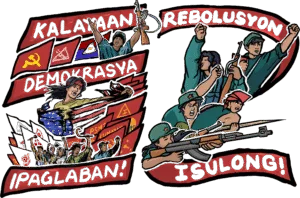III. The Party leads the revolution
The Communist Party of the Philippines has successfully led the Philippine revolution for over 42 years since its founding. It has defeated all the military campaigns of suppression unleashed by the Marcos regime to "nip the revolution in the bud" from 1969 to 1972 and the 14 years of fascist dictatorship from 1972 to 1986; and thereafter, the various campaigns of the post-Marcos regimes from 1986 to the present.
It has grown from small to big and from weak to strong through fierce revolutionary struggles. It has become tempered in battles against the enemy forces and overcome tremendous odds and difficulties. It has gained rich experience from which to draw lessons in order to advance the people's war from the strategic defensive to the strategic stalemate in five years.
The Party has won great victories in the fields of ideology, politics and organization. It has upheld, defended and promoted Marxism-Leninism-Maoism as the theory of the revolutionary proletariat. It has applied this theory on Philippine history and circumstances in order to determine the character of Philippine society and to draw the general political line of new democratic revolution through protracted people's war. It has adhered to the principle of democratic centralism in building an organization that is deeply rooted among the toiling masses throughout the country.
The Party has gained strength and competence in leading the Philippine revolution because it has resolutely and diligently built itself ideologically, politically and organizationally. Criticism and self-criticism are conducted regularly and in a timely way in all organs and units to identify and overcome errors and shortcomings and to improve work and style of work. When errors and shortcomings of major proportions are committed, higher organs conduct rectification campaigns of varying scale and duration.
The CPP Central Committee initiated and led the Second Great Rectification Movement (SGRM) from 1992 to 1998 that identified, criticized, repudiated and rectified major errors of Left opportunism and Right opportunism arising from the subjectivist notion that the Philippines has ceased to be semifeudal. The Left opportunists who pushed the lines of "strategic counteroffensive" and "urban insurrectionism" (Red Area-White Area, etc.) departed from the strategic line of protracted people's war and undermined the mass base of the revolutionary movement. Subsequently, they conjoined with the Right opportunists who got carried away by Gorbachovism, Trotskyism, bourgeois liberalism and other petty bourgeois trends and who were most vocal in espousing the liquidation of the Party.
The Party held its ground against the opportunists and called for the reaffirmation of basic revolutionary principles and the rectification of errors. It confronted and defeated the opportunists on all major issues, renewed the criticism and repudiation of modern revisionism in view of the blatant and full-scale restoration of capitalism in revisionist-ruled countries. It combatted the ideas and policies related to the ideological, political, economic and military offensives of the US and its allies against the cause of national liberation, democracy and socialism.
The SGRM held the incorrigible opportunists and renegades accountable for gross ideological and political errors and for crimes arising from hysterical anti-informer campaigns. It frustrated and defeated the wrecking operations of the opportunists who eventually exposed themselves as renegades and special agents of the enemy. Ideological work was intensified. Through vigorous efforts, the Party successfully recovered and expanded the mass base in rural and urban areas. But certain aspects and areas of work did not get prompt and proper attention until after the SGRM.
The Party was able to preserve itself and gain strength under the worst conditions of adversity. It was still in the process of laying its foundation when Marcos imposed the fascist dictatorship and sought to destroy the revolutionary movement. In the time of the first Aquino regime, the military campaigns called Lambat Bitag coincided with the opportunist lines still at work within the Party. The Ramos and Estrada regimes continued the campaigns of suppression while the Party concentrated on the rectification movement and the recovery of the mass base.
The Arroyo regime carried out Oplan Bantay Laya (OBL) for nearly ten years. The victories gained from the SGRM served the revolutionary movement well. In certain regions, the revolutionary forces that came under concentrated enemy attack became stronger. Others maintained their strength to be able to fight back in armed and legal struggles. One region was able to surmount the whole course of OBL I but declined in both armed and legal forms of struggle in the course of OBL II. In certain regions, the revolutionary forces grew because the enemy military forces were sparse due to overextension elsewhere.
Even when the enemy forces launched the most brutal campaigns of military suppression, the Party has been able to engage in ideological building by undertaking courses at the primary, intermediate and advanced levels in many rural and urban areas. It is impossible for the enemy to stop ideological and political studies in so many guerrilla fronts, mountainous sites, private homes, offices and campus grounds apart from studies conducted in guerrilla fronts under concentrated attack by the enemy forces.
It is absolutely necessary to have Party cadres and members who have a sufficient level of theoretical knowledge of Marxism-Leninism-Maoism. They serve as the hard core of the revolutionary movement. The long life and victories of the Party and the entire revolutionary movement are assured as the number of Marxist-Leninist-Maoists keep on increasing.
Theoretical and political studies have been facilitated and accelerated by the translation of the classics and major Party documents in various Philippine languages, by the legal availability of these in hard copies and on the internet in digital copies, by simplified study materials and by the use of audio-visual media and illustrations in hard and digital copies,
The Party has consistently promoted the general political line of democratic revolution through protracted people's war in response to the semcolonial and semifeudal conditions that have not only persisted but also worsened and deepened under the policy regime of neoliberal globalization and the global war of terror pushed by the US imperialists. The Party has taken up all the major political, economic, social, cultural and military issues related to the general line of the revolution. It has debated with and defeated the exponents of blatant counterrevolution and reformism.
The Party has vigorously aroused, organized and mobilized various sections of the masses to undertake various forms of struggle against the current enemy and the entire ruling system. The mass movement has continued to persevere and grow in both urban and rural areas. It can grow faster than ever as it responds to the demands of the masses themselves and members of mass organizations are recruited in accordance with easily understood constitutions and programs of such organizations.
There is no way for the enemy to stop the mass organizations, especially because of the worsening political and economic crisis of the ruling system. But certain mass organizations and alliances have declined not so much because of the enemy campaigns of suppression but because of errors and shortcomings of leadership in the Party organs concerned.
The mass movement of workers, peasants, youth, women, professionals and other people is the source of Party members and NPA fighters. It is the force by which the masses themselves express their needs, demands and aspirations. It is the force by which they can build and appreciate their own strength. It is also the force by which various types of alliances can be formed.
The New People's Army has 110 to 120 guerrilla fronts that cover significant portions of 800 municipalities in 70 provinces. The number of guerrilla fronts fluctuates because of concentrated enemy attacks with varying durations. The enemy has no capability to concentrate attacks on more than 10% of the guerrilla fronts at every given time.
To frustrate and defeat concentrated attacks by the enemy forces, the NPA can shift its forces, leave units to pin down the enemy and launch offensives at the weakest points of the enemy elsewhere. While the enemy can concentrate strength on less than 10% of the Philippines, the NPA can move around freely in more than 90%.
The NPA continues to integrate the revolutionary armed struggle with genuine land reform and the building of the mass base and organs of political power. It is invincible because it smashes the bureaucratic military power of the state, responds to the peasant demand for land and realizes land reform as the main content of the democratic revolution and because it builds the people's democratic state of workers, peasants and other people.
The National Democratic Front is effectively harmonizing 17 revolutionary forces consisting of the Party, the NPA and the underground revolutionary mass organizations of workers, peasants, national minorities, women, youth, teachers, health professionals, lawyers, scientists and technologists, writers and artists, the religious and other sectors. It is a united front for armed struggle. At the same time, all the revolutionary forces have authorized it to engage in peace negotiations with the reactionary government.
The peace negotiations have dragged on because one reactionary regime after another has sought to use it in futile attempts to deceive the people, split the revolutionary forces and press the NDFP towards capitulation and pacification. But the NDFP has correctly and consistently asserted that the framework agreement, The Hague Joint Declaration, must be followed and that the roots of the armed conflict must be addressed through basic social, economic and political reforms to lay the basis for a just and lasting peace.
The Party and the NDFP have served well the people and the revolutionary forces by declaring that the line of negotiations for a just peace is no different from the line of struggle for national liberation and democracy. A just peace can be achieved in the following ways: the complete victory of the armed revolution, the emergence of an anti-imperialist coalition government or an anti-imperialist alliance and truce.
None of these possibilities is easily attainable because the enemy persists in trying to destroy the revolutionary movement of the people. The NDFP carries on the peace negotiations because these provide the opportunity to articulate the program for a people's democratic revolution, to win more adherents to the revolution and to be open to possibilities presented by the worsening crisis of the ruling system and the world capitalist system.

